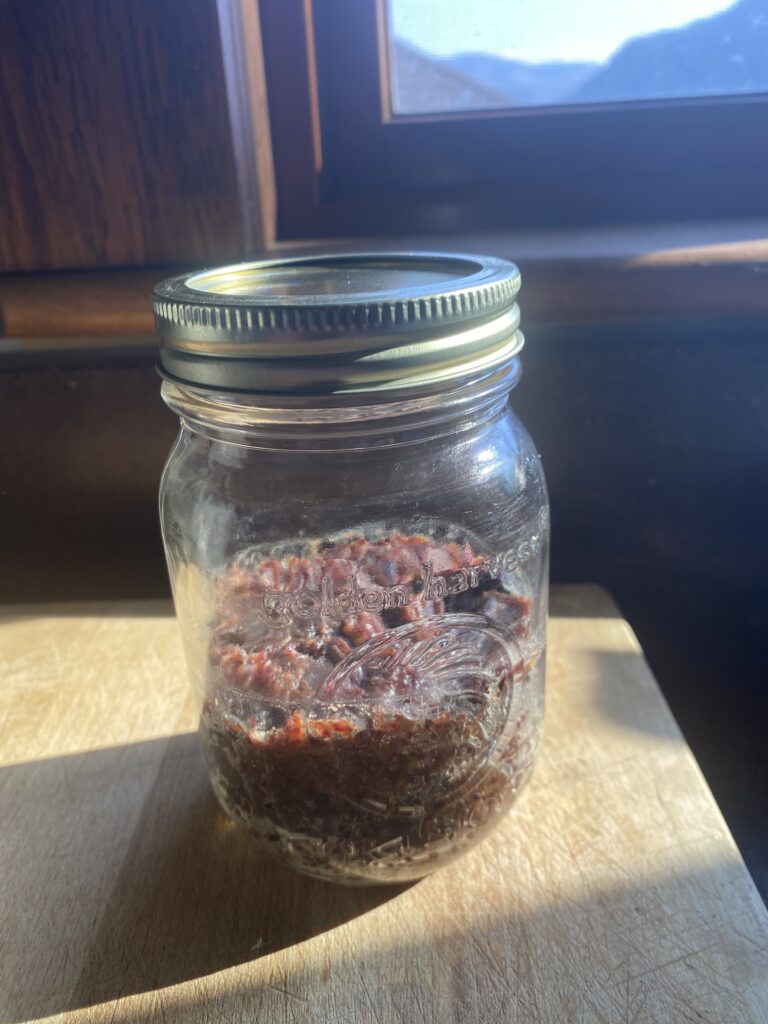




TRU Open Learning





Dried meat (buffalo, game or beef)
Dried cranberries (use about the same amount as the dried meat)
Sugar to taste
Lard (to hold together)
Pound meat very thin and dry in the oven. Grind the dried meat in a food processor. Add dried berries and blend together (the consistency should be dry and loose with fruit broken up). Add melted lard slowly while mixing. Store in paper or plastic or glass.

adapted from the First Nations Development Institute’s recipe for Pemmican
Métis women were central to the social, economic, and cultural landscape of Canada’s fur trade. Despite this, very little is documented in historical records about their contributions to the birth of our nation. Telling the stories of these women’s lives adds to the rich cultural history of Canada and to the identity of the Métis people.
It is not surprising that women’s histories have been neglected. According to USask Indigenous Studies graduate researcher Kate Gillis, the common historical narratives revolve around men, individualism, and patriarchy. Since records of women’s activities were not a priority at that time, it is difficult to locate stories of Métis women, their lives, and their contributions. By researching and telling their stories, we are giving a voice to those women who did not have the opportunity to do so.
As reported in The Canadian Encyclopedia, the fur trade began in the 1600s with France and Britain battling for control over what is now Canada. Britain took control in the 1760s and the rise of fur trading companies followed soon after. The Hudson’s Bay Company and the North West Company expanded from east to west across Canada, concentrating in the Red River Valley in Manitoba. European men immigrating to Canada to participate in the fur trade soon began to have children with Indigenous women, leading to a post-contact Indigenous people now known as the Métis.

Saskatoon berries. Photo taken by S. Franklin, 2024
The first generation of Métis women were born between 1770-1790. These women were central to Canadian society at the time and to establishing the Métis identity. In the article, Emerging Voices of Métis Women, Leah Dorion reports that Métis societies were matriarchal and that Métis women held social and political power. Women were treated as equal partners in social, economic, and political spheres. According to Women of the Métis Nation, they participated in the bison hunt by processing game and preparing hides, they worked as guides and interpreter to European settlers and they were in charge of producing pemmican, a staple that sustained the fur trade.
“Over time there was an erosion of the status of Métis women due to the Europeanization of their communities”, states Dorian. Despite their accomplishments, Métis women were dismissed and devalued. If women were mentioned in historical literature at all, it was with derogatory or racist language. Not only were Métis women marginalized, but their presence and their voices were erased from history. Métis women were denied the opportunity to see themselves in the records of their own culture.
To reclaim the narratives of these Métis women, we must begin to tell their stories, reclaim their voices and honour their lives. For my part, I am going to tell the story of my great-great-great-grandmother, Sarah Cree. As detailed in Red River Ancestry.ca, Sarah was born in 1776 in Fort Severn on the shores of Hudson Bay, one of the earliest English fur trading posts. It was in Fort Severn that she met her future husband Thomas Thomas, a young surgeon working for the North West Company who had arrived in Fort Severn in 1796. A few years after meeting, Thomas and Sarah’s first child Frances was born. They would have seven more children altogether including William, my great-great-grandfather.

Old photo of Isabella Harriet Dahl and William Thomas. Photographer and date unknown
Sarah’s partner Thomas Thomas became a leader amongst settlers and was appointed to a governorship of the Hudson’s Bay Company. The family moved to the Red River Valley and settled at Lower Fort Garry, Manitoba. Sarah lived in this area until her death in 1846. Throughout her lifetime, many historic events occurred including the Pemmican War (1814), the Seven Oaks Massacre (1816) and the signing of the Selkirk Treaty (1817). Sarah experienced it all first hand.
Despite past and present challenges, Métis women are finding their voice. Scholars like Kate Gillis and Leah Dorian are pursuing research so that Métis and Indigenous women will no longer be rendered historically voiceless. Sarah Cree is just one example of an Indigenous woman whose story could add to the collective identity of the Métis nation. However, it takes active participation to have these important stories told. Telling Sarah’s story is my way of reclaiming a Métis woman’s voice and honouring her life. Whose story will you tell?
© 2025 Untold Stories of Métis Women
Theme by Anders Noren — Up ↑